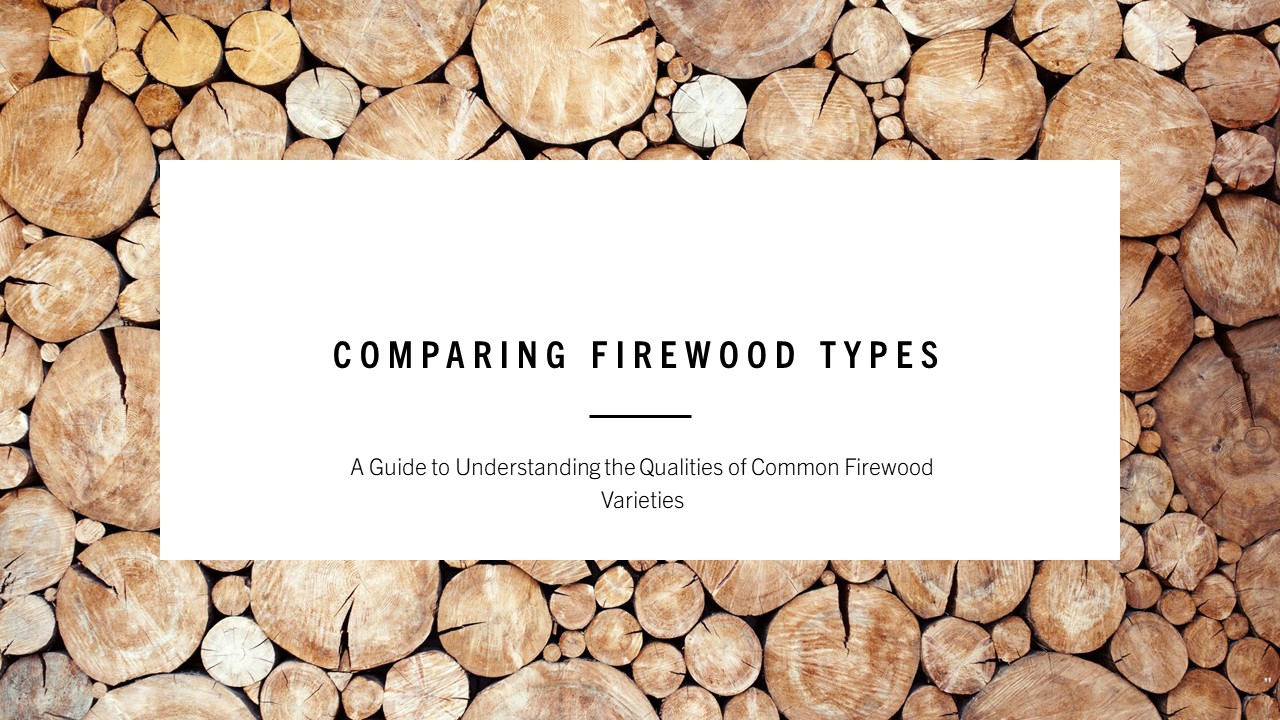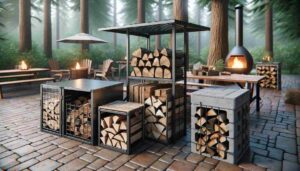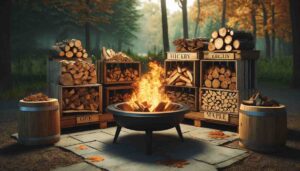When it comes to heating your home or enjoying a cozy evening around a campfire, the type of firewood you choose can make a significant difference in terms of efficiency, heat output, and overall experience. Not all firewood is created equal, and understanding the qualities of common firewood varieties is essential for getting the most out of your firewood. In this comprehensive guide, we’ll explore the characteristics of various firewood types, helping you make informed choices for your heating or recreational needs.
Introduction to Firewood
Firewood has been a primary source of heat and energy for millennia, dating back to when our ancestors discovered the power of fire. Today, it still serves as a valuable resource for heating homes, cooking, and providing a source of warmth during outdoor activities like camping. However, not all types of firewood are suitable for all purposes, and selecting the right one is crucial for efficient and enjoyable fires.
Several factors determine the quality and performance of firewood, including its density, moisture content, heat value, and ease of splitting and burning. By understanding these qualities and how they vary across different firewood types, you can make informed decisions to meet your specific needs.
Factors to Consider When Comparing Firewood Types
Before delving into specific firewood types, let’s take a closer look at the key factors to consider when comparing different varieties:
1. Density
The density of firewood refers to how tightly the wood fibers are packed together. Denser firewood typically burns longer and produces more heat. Hardwood varieties tend to be denser than softwoods, making them a popular choice for heating purposes.
2. Moisture Content
The moisture content of firewood is a critical factor affecting combustion efficiency. Green or freshly cut wood contains a high moisture content, which makes it less suitable for burning. Seasoned or well-dried firewood, on the other hand, burns more efficiently, producing less smoke and more heat.
3. Heat Value
The heat value of firewood, measured in British Thermal Units (BTUs) per cord, tells you how much heat the wood can produce when burned. Different types of firewood have varying heat values, with hardwoods generally having higher BTU ratings than softwoods.
4. Ease of Splitting
The ease with which firewood can be split into smaller pieces is another essential factor to consider, especially if you’re cutting your own wood. Some types of wood are easier to split than others, saving you time and effort in preparing your firewood.
5. Burning Characteristics
Each type of firewood has unique burning characteristics. Some woods produce long-lasting, hot flames, while others may burn quickly and produce sparks. Understanding these characteristics can help you choose the right wood for your specific needs.
Common Firewood Varieties
Now that we have a clear understanding of the factors to consider when comparing firewood types, let’s explore some of the most common varieties and their qualities:
1. Oak (Quercus spp.)
Density: High
Moisture Content: Low when seasoned
Heat Value: Excellent (28-32 million BTUs per cord)
Ease of Splitting: Moderate to difficult
Burning Characteristics: Slow-burning, long-lasting, and produces a steady, hot flame
Oak is widely regarded as one of the best firewood choices. Its high density and low moisture content when properly seasoned make it an excellent source of long-lasting, high-heat fires. While it can be more challenging to split than some other woods, the effort is well worth it for its superior burning characteristics.
2. Maple (Acer spp.)
Density: High
Moisture Content: Low when seasoned
Heat Value: Excellent (25-28 million BTUs per cord)
Ease of Splitting: Moderate
Burning Characteristics: Burns hot and steady, with a pleasant aroma
Maple is another hardwood known for its excellent burning qualities. It has a high density and a low moisture content when properly dried, making it an efficient choice for heating. Maple also produces a pleasant aroma when burned, adding to the overall experience.
3. Hickory (Carya spp.)
Density: High
Moisture Content: Low when seasoned
Heat Value: Excellent (27-29 million BTUs per cord)
Ease of Splitting: Difficult
Burning Characteristics: Provides high heat, slow-burning, and imparts a sweet, smoky flavor when used for cooking
Hickory is famous for its use in smoking meats due to its unique flavor. It is a dense hardwood with a low moisture content when properly seasoned, making it an excellent choice for both heating and cooking. However, it can be challenging to split, so be prepared for some extra effort in the wood preparation process.
4. Cherry (Prunus spp.)
Density: Medium to high
Moisture Content: Low when seasoned
Heat Value: Good (20-24 million BTUs per cord)
Ease of Splitting: Moderate
Burning Characteristics: Burns with a pleasant aroma, produces a steady flame
Cherry wood is prized for its sweet aroma and beautiful, reddish-brown color when burned. While it has a slightly lower heat value compared to some hardwoods, it still provides an excellent source of heat. Its moderate density and ease of splitting make it a popular choice for those seeking a combination of aesthetics and functionality.
5. Ash (Fraxinus spp.)
Density: High
Moisture Content: Low when seasoned
Heat Value: Excellent (23-29 million BTUs per cord)
Ease of Splitting: Easy to moderate
Burning Characteristics: Burns hot and steady, produces minimal smoke
Ash wood is prized for its high density, making it an excellent choice for producing a steady, hot fire. It’s relatively easy to split, which can save you time and effort during wood preparation. Ash wood also produces minimal smoke, contributing to a cleaner burn.
6. Pine (Pinus spp.)
Density: Low to medium
Moisture Content: Low when seasoned
Heat Value: Fair to good (15-20 million BTUs per cord)
Ease of Splitting: Easy
Burning Characteristics: Burns quickly, may produce more creosote and sparks
Pine is a popular softwood option due to its ease of splitting and ready availability. While it has a lower heat value compared to hardwoods, it can still provide adequate heat when properly seasoned. However, pine tends to burn quickly, so it may require more frequent reloading. Additionally, it can produce more creosote buildup in chimneys, which requires regular maintenance.
7. Cedar (Cedrus spp.)
Density: Low to medium
Moisture Content: Low when seasoned
Heat Value: Fair to good (15-20 million BTUs per cord)
Ease of Splitting: Easy
Burning Characteristics: Burns quickly, imparts a pleasant aroma, and may produce sparks
Cedar is known for its pleasing aroma and ease of splitting, making it a popular choice for kindling and outdoor fires. While it doesn’t have the highest heat value, it still provides decent warmth when burned. However, like pine, cedar tends to burn quickly and may produce sparks, so it’s best used in combination with other woods for longer-lasting fires.
8. Spruce (Picea spp.)
Density: Low to medium
Moisture Content: Low when seasoned
Heat Value: Fair to good (15-20 million BTUs per cord)
Ease of Splitting: Easy
Burning Characteristics: Burns quickly, may produce more creosote and sparks
Spruce is another softwood that is readily available and easy to split. It has a similar heat value to pine and cedar and shares some of the same burning characteristics. While it can provide adequate heat, be prepared for faster burn times and potential creosote and spark production.
Choosing the Right Firewood for Your Needs
Now that we’ve covered various firewood types and their qualities, let’s discuss how to choose the right firewood for your specific needs:
1. Heating Your Home
If you’re using firewood as a primary heat source for your home, it’s best to opt for dense hardwoods like oak, maple, hickory, or ash. These woods burn longer and hotter, providing a consistent source of warmth. Remember to season the wood properly to reduce moisture content and enhance combustion efficiency.
2. Cooking or Smoking
For cooking or smoking food, hardwoods like hickory, maple, and cherry are excellent choices due to their pleasant flavors and high heat values. These woods can impart a delicious smoky taste to your dishes. Make sure the wood is well-seasoned and free of any chemicals or contaminants.
3. Campfires and Outdoor Fires
When enjoying outdoor fires or campfires, softwoods like pine and cedar are convenient options due to their easy splitting and ignition. However, it’s essential to exercise caution when using softwoods indoors, as they can produce more creosote and sparks, posing a potential fire hazard.
4. Kindling
If you need firewood specifically for kindling or starting fires, cedar and spruce are excellent choices. They ignite quickly and produce a pleasant aroma, making them ideal for getting fires started.
5. Chimney Maintenance
Regular chimney maintenance is crucial when burning firewood. Regardless of the wood type you use, creosote buildup can occur, increasing the risk of chimney fires. Consider using a creosote-reducing additive and have your chimney cleaned regularly by a professional to ensure safety.
Proper Firewood Storage and Seasoning
Regardless of the firewood type you choose, proper storage and seasoning are essential for getting the best performance and efficiency from your wood. Here are some tips for storing and seasoning firewood:
1. Season Your Firewood
Seasoning involves drying the wood to reduce its moisture content, typically to around 20% or lower. Properly seasoned wood burns more efficiently, produces less smoke, and generates more heat. It’s crucial to split and stack the wood in a dry, well-ventilated area, allowing air to circulate and moisture to evaporate. Seasoning times can vary, but it often takes six months to a year for wood to dry adequately.
2. Stack Firewood Properly
When stacking firewood, create a raised platform or use pallets to keep the wood off the ground. This helps prevent moisture absorption from the soil and promotes airflow beneath the woodpile. Stack the wood loosely, leaving gaps between pieces to allow for better ventilation.
3. Cover the Woodpile
Protect your seasoned firewood from rain and snow by covering the woodpile with a tarp or a purpose-built firewood rack cover. Ensure that the cover allows for proper ventilation to prevent mold and mildew growth.
4. Store Wood in a Dry Location
Choose a dry, well-ventilated location for storing your firewood. Avoid stacking wood against the side of a building, as this can trap moisture and encourage pests. A dedicated woodshed or covered storage area is ideal.
5. Rotate Your Stock
Use a “first in, first out” system to ensure you’re burning the oldest, driest wood first. This prevents wood from becoming overly seasoned and reduces the risk of rot.
Safety Considerations
Using firewood for heating or recreational fires comes with certain safety considerations:
1. Chimney Inspection and Cleaning
Regularly inspect and clean your chimney to remove creosote buildup. This reduces the risk of chimney fires, which can be dangerous and destructive.
2. Maintain Adequate Ventilation
When using indoor fireplaces or wood-burning stoves, ensure proper ventilation to prevent the buildup of carbon monoxide. Install and regularly check carbon monoxide detectors in your home.
3. Keep a Safe Distance
Maintain a safe distance between outdoor fires and flammable structures, foliage, and overhanging branches. Always follow local fire safety regulations and guidelines.
4. Supervise Fires
Never leave a fire unattended, especially when children or pets are present. Ensure that fires are completely extinguished before leaving the area.
5. Use Proper Fire Starting Methods
Use safe and appropriate methods for starting fires, such as kindling, firestarter logs, or firestarter cubes. Avoid using accelerants like gasoline, which can lead to dangerous flare-ups.
Conclusion
Choosing the right type of firewood is crucial for a safe, efficient, and enjoyable fire experience, whether you’re heating your home, cooking, or simply relaxing around a campfire. Understanding the qualities and characteristics of common firewood varieties can help you make informed decisions that suit your specific needs.
Remember to consider factors such as density, moisture content, heat value, ease of splitting, and burning characteristics when comparing firewood types. Additionally, proper storage and seasoning are essential to maximize the performance of your firewood.
By selecting the appropriate firewood and following safety guidelines, you can create warm, inviting fires that enhance your comfort and enjoyment while minimizing environmental impact and safety risks. So, whether you’re curling up by the fireplace on a chilly evening or gathering around a campfire with friends and family, choose your firewood wisely and make the most of your fire experience.










